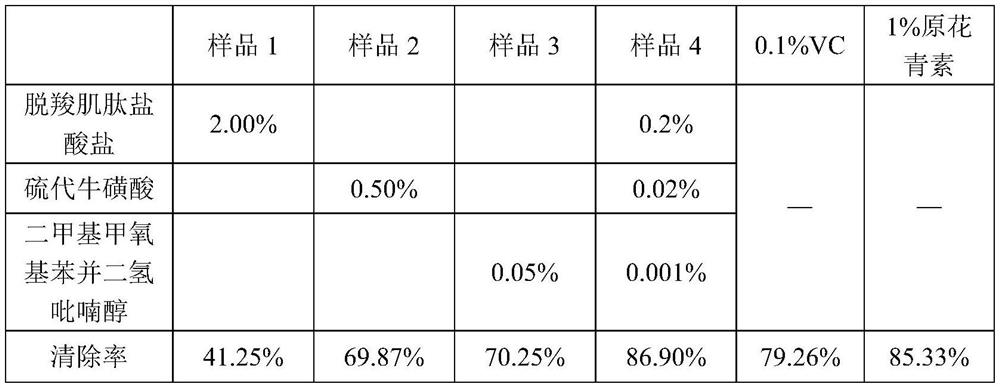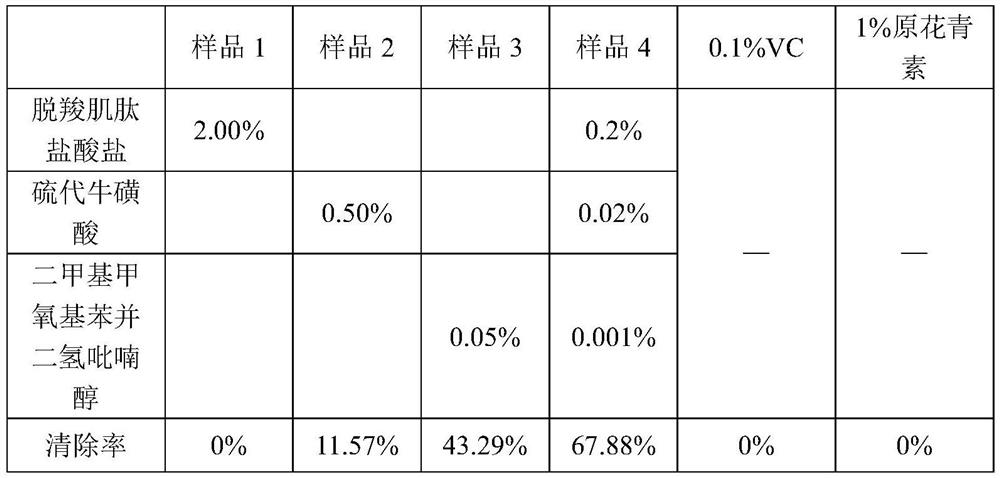Antioxidant composition with synergistic effect
A composition and anti-oxidation technology, applied in the direction of medical preparations containing active ingredients, cosmetics, cosmetics, etc., can solve the problems of antioxidant inactivation, unstable antioxidant components, and weak antioxidant capacity Lipid peroxidation ability, enhanced oxidative stress defense, and reduced oxidative failure effects
- Summary
- Abstract
- Description
- Claims
- Application Information
AI Technical Summary
Problems solved by technology
Method used
Image
Examples
preparation example Construction
[0029] The preparation method of the antioxidant composition comprises the following steps:
[0030] ①Add 2.5g of caprylic / capric acid triglyceride per 0.001g of dimethylmethoxychromanol, then heat to 80-85°C at a speed of 1-2°C / min to dissolve it uniform, get A grade;
[0031] ② After heating 0.8g of polyglycerol-10 laurate to 80-85°C, slowly add it to product A and mix well to obtain oil phase B;
[0032] 3. Add 4g of PEG / PPG-14 / 7 dimethyl ether to 80g of deionized water, and heat it to 70 to 80°C at a rate of 0.5 to 1°C / min to obtain c1 water phase; then slowly add B oil phase In the aqueous phase of c1, and replenishing water to 99.78g to obtain C mixture;
[0033] 4. After the C mixture was cooled to 45°C, 0.02 g of thiotaurine was added to obtain the D mixture;
[0034] ⑤ After the D mixture was continuously cooled to 38° C., 0.2 g of decarboxylated carnosine was added to make the final mass of the mixture reach 100 g to obtain a finished antioxidant composition.
[...
experiment example 1
[0043] Experimental Example 1: The antioxidative ability of the sample was tested with the quenching ability to singlet oxygen as an index.
[0044] Wherein sample 1 is 2.00% (mass concentration) decarboxylated carnosine hydrochloride, sample 2 is 0.5% thiotaurine, sample 3 is 0.05% dimethylmethoxychromanol, sample 4 is an antioxidant composition consisting of 0.2% decarboxylated carnosine hydrochloride, 0.02% thiotaurine and 0.001% dimethylmethoxychromanol. Singlet oxygen quenching ability. The test results are shown in Table 1:
[0045] Table 1 The scavenging rate of each sample to singlet oxygen quenching
[0046]
[0047] The effective concentration of decarboxylated carnosine is 0.75%, the effective concentration of thiotaurine is 0.002%, and the effective concentration of dimethylmethoxychromanol is 0.00001%. A single antioxidant at a super-effective concentration was used as a sample for comparison. As can be seen from the test results, sample 4, by the combination...
experiment example 2
[0052] Experimental Example 2: Using the ability of the sample to reduce the oxidized fatty acid (LOOH) formed by lipid peroxidation to a non-toxic fatty alcohol (LOH) as an index, the ability of the sample to scavenge lipid peroxides was tested. Among them, sample 1 is 2% decarboxylated carnosine hydrochloride, sample 2 is 0.5% thiotaurine, sample 3 is 0.05% dimethylmethoxychromanol, and sample 4 is from 0.2 Antioxidant composition consisting of % decarboxylated carnosine hydrochloride, 0.02% thiotaurine and 0.001% dimethylmethoxychromanol. The LOOH and LOH content in each sample were tested by HPLC. The test results are shown in Table 3:
[0053] Table 3 Oxidized fatty acid scavenging rate of each sample
[0054]
[0055]
[0056] According to the test results, sample 4 can effectively improve the scavenging ability of lipid peroxides compared with the other three groups of samples. By compounding the two components of thiotaurine and dimethylmethoxychromanol, the e...
PUM
 Login to View More
Login to View More Abstract
Description
Claims
Application Information
 Login to View More
Login to View More - R&D
- Intellectual Property
- Life Sciences
- Materials
- Tech Scout
- Unparalleled Data Quality
- Higher Quality Content
- 60% Fewer Hallucinations
Browse by: Latest US Patents, China's latest patents, Technical Efficacy Thesaurus, Application Domain, Technology Topic, Popular Technical Reports.
© 2025 PatSnap. All rights reserved.Legal|Privacy policy|Modern Slavery Act Transparency Statement|Sitemap|About US| Contact US: help@patsnap.com



